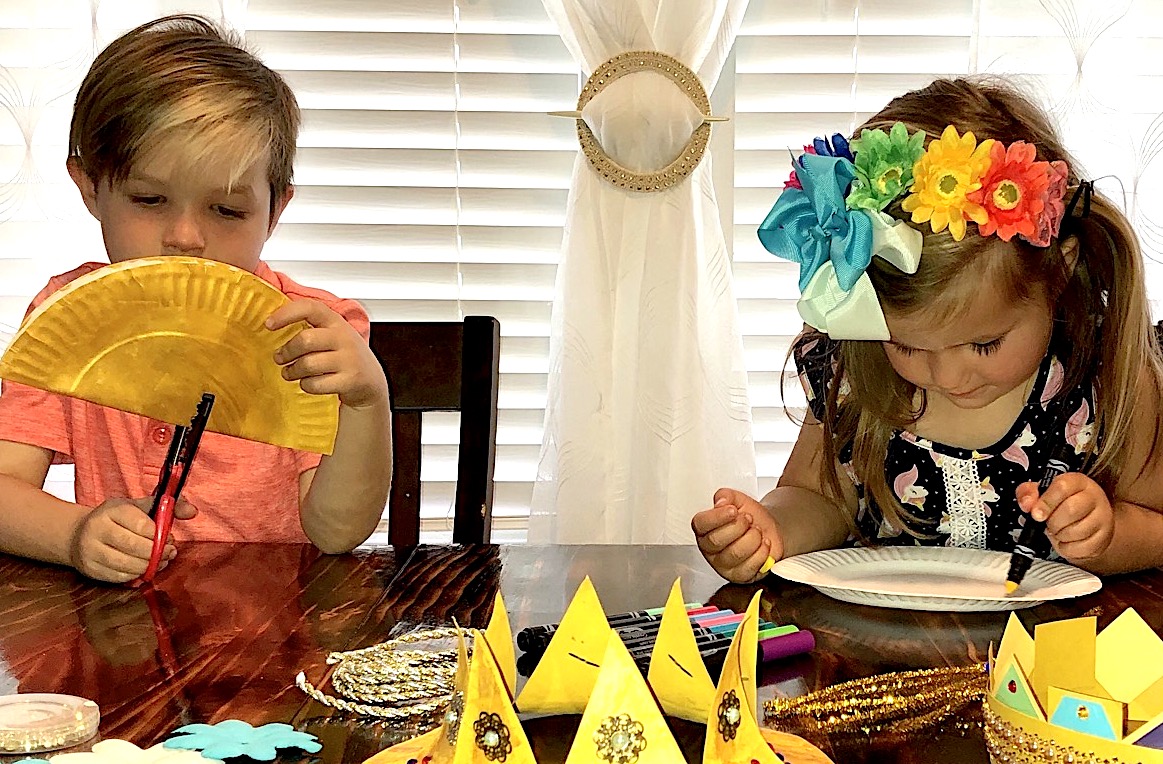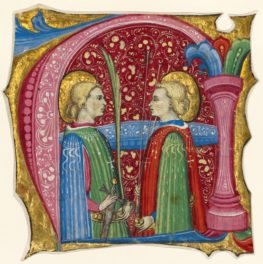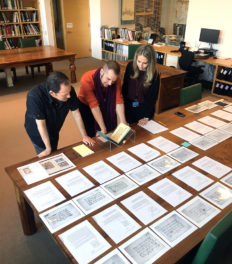
Often made from gold, silver, or other metal bands and embellished with gems or jewels, crowns are among the most prevalent symbols of royal or saintly status.
In the illumination below, King Louis XII of France kneels atop a cushion with a fleur-de-lis design (a stylized lily flower) that symbolizes French royalty. Four saints make up his entourage: Michael the Archangel, wearing a diadem and holding a cruciform staff; Charlemagne, with the hoop crown of the Holy Roman Empire; Louis IX with the crown of France; and Denis, patron saint of the royal household, shown dressed in bishop’s robes and wearing a miter on his head.

Louis XII of France Kneeling in Prayer, Accompanied by Saints Michael, Charlemagne, Louis, and Denis, 1498–99, Jean Bourdichon. Tempera and gold on parchment, 9 9/16 × 6 3/16 in. The J. Paul Getty Museum, Ms. 79a (2004.1), recto. Digital image courtesy of Getty’s Open Content Program
In the Middle Ages and Renaissance, the crown’s jewels carried their own symbolism. For example, emeralds could be used to predict the future, diamonds could protect against nightmares, rubies could neutralize poison, sapphires could make the wearer joyous, and turquoise could ward off all evil.

The Coronation of the Virgin, about 1480–1490, Jean Bourdichon. Tempera colors, gold leaf, gold and silver paint, and ink on parchment, 4 1/2 × 3 3/8 in. The J. Paul Getty Museum, Ms. 48 (93.ML.6), fol. 73v. Digital image courtesy of Getty’s Open Content Program
To understand the power of these gems, the wearer would turn to a manuscript called a lapidary, which contained scientific and medicinal accounts about precious and semi-precious stones. This type of book was often read together with a bestiary (a book of beasts), an herbal (a book of plants), and other medicinal texts (including treatises on alchemy and pigments)—making these the ultimate gift for anyone interested in the natural world.

The Adoration of the Magi, about 1480–90, Georges Trubert. Tempera colors, gold leaf, gold and silver paint, and ink on parchment, 4 1/2 × 3 3/8 in. The J. Paul Getty Museum, Ms. 48 (93.ML.6), fol. 59. Digital image courtesy of Getty’s Open Content Program
There is no limit to the types of crowns you can make. Find in-depth, step-by-step instructions for a radiant crown, a coronation crown, and a royal crown here.
How to Make a Radiant Crown
The radiant crown rings the wearer’s head like a sunburst, with gold, silver, or other metallic bands emerging like rays of light. Manuscript illuminator Taddeo Crivelli depicted the biblical King David wearing such a crown and included golden light from heaven to suggest a dialogue between the figure and God beyond.

Initial D: David in Prayer, about 1469, Taddeo Crivelli. Tempera colors, gold paint, gold leaf, and ink on parchment, 4 1/4 × 3 1/8 in. The J. Paul Getty Museum, Ms. Ludwig IX 13 (83.ML.109), fol. 78v. Digital image courtesy of Getty’s Open Content Program
First, gather your materials

Primary: construction paper, cardstock, paper plates, crayons, colored pencils, markers, paints, brushes, glue (glue sticks or white glue), tape, scissors, ruler
Optional: stapler, glue gun, hole punch
Alternative: paper bags, gift bags, scrapbook papers, cereal boxes, lightweight cardboard or foam sheets
Royal Bling: decorative stickers, glitter, sequins, tin foil, noodles, cereal, lace, pompoms, pipe cleaners, or cut paper shapes. You can cut or hole-punch elements from old greeting cards or wrapping paper for more decorative options. Use your imagination!
Tips for starting
- Gather all materials beforehand. If you don’t have the exact materials, improvise! (cereal boxes make a great base for a crown!)
- Try a practice run to get familiar with the crown designs.
- Think about who or what you are celebrating as you decorate your crown. Make it personally meaningful and have fun!
Instructions



- Get a paper plate (preferably 9 inches in diameter, uncoated)
- Decorate the backside with paint, crayons, colored pencils, markers, etc.
- Let dry.
- Fold the paper plate in half so decorated side is visible.
- Cut through the center of the folded plate. Start the cut at the folded edge, leaving an inch of uncut border at the open edge.
- Next, make similar cuts through the center of the two halves created to make four equal triangles (or imagine four slices of pie!).
- Open the paper plate and cut the two larger triangles in half (along the crease line) for a total of eight triangles.
- With decorated side up, fold each triangle up and away from the center to form the rays of the crown.
- Crease each triangle or ray at the base so they stand upright.
- Enjoy the royal treatment! Or continue to embellish with lightweight decorations like stickers, glitter, sequins, lace, and cut paper shapes.

The “radiant crown” or “sun crown” is distinguished by its ray-like pattern that symbolizes the power of the sun. It is an ancient crown shape that you might recognize from the Statue of Liberty.
Find more crown projects for all ages here.

The author and his family wear the crowns they made.




Very lovely!
Yes! Happy Father’s Day
Thank you for this beautiful family fun idea.
Now I feel ready for Fathers Day
What fun! (And, what a beautiful family!) Thanks so much for this! Outstanding!
Thank you for this totally inspired mailing thank you for including so much information and how tos what a perfect email
Great idea!!! Fun for families!! Now we have a Fathers Day activity’!!
Bryan this is fantastic! I’m sending the link right away to my kids and grandkids so those four fathers can be decorously celebrated. And in their absence, I might even make a crown for my kids’ father!
What a charming family photo! Thanks for the uplifting picture. I really enjoy reading the Getty newsletter and blogs as we cant visit the Getty.
From Victoria, BC, Canada.
So cute and fun! And what a great way to get kids *of any age…) interested in being inspired by art!!!! That kind of art inspired project could work any time…
All four crowns are adorable. I like this art activity and the information regarding where the inspiration came from.
Lovely family picture.
Happy Father’s day! Beautiful family.
Thanks for the fun activity and great article.
i love this idea. Thank you for figuring out how to do them. Wonderful and adorable.
Wonderful photo, terrific crowns, beautiful and creative(!) children. Thank you for the peek into this lovely celebration
I lived in Dijon, France in the mid-60s and studied at the university there. One of the courses was on manuscripts from the 13th to 15th centuries. I particularly remember the Belles Heures of the Duc de Berry — superbe! I think I’ll follow your instructions and make a crown for myself — at 75!
Tis the day a good day, the night, a peaceful night. May all the world, transition of the good there is.
With geese flying through the world, at times to tend, and be alert, to more that the world can be.
Thank you to the Getty museum of art in Los Angeles California for the wonderful emails in 2020, that are to savior in the hopes of a full USA recovery.